
Interior
Each side panel involves removing four screws. It's hardly a difficult procedure but we've become so used to thumbscrews that it does feel a bit fiddly, especially if you're a serial tinkerer. A hinged door system like the Phanteks Enthoo EVOLV uses would be well suited to a case with this design, but equally these cases are in two rather different price categories.Inside, you find pre-installed motherboard mounts, black sleeved cables and a cutout to help with installing CPU coolers, though in a case this size we'd still prefer to do that externally. Thumbscrews aren't used anywhere in the Styx, though one thing modders will like is that the case frame is held together with a lot of screws (rather than rivets everywhere), so disassembly should be relatively easy.
Starting at the front, two plastic brackets fixed to the back of the front panel form the slimline ODD mount. Right behind this is the PSU mount, so once your system is built access to the ODD drive will be very tricky. Still, this is an extremely compact micro-ATX case and that always involves a compromise or two. Plus, the ODD drive is hardly a component that requires repeated upgrades.
The PSU bracket allows your PSU to be installed in either orientation, though Raijintek recommends having the fan facing into the chassis, thus acting as a secondary exhaust. This does make the most sense – it would be useless trying to suck air through that thick front panel. However, as you may have noticed, and as with the Metis before it, this means it will be pulling air in the complete opposite direction to the other exhaust fan and also your CPU cooler fan. This created a rather dire situation for CPU cooling in the Metis – as we said, we'll be testing in the default configuration and with the exhaust and CPU cooler fan reversed so as to create a back-to-front airflow arrangement. You can see the results on the next page.
We also recommend using as short a PSU as possible with the Styx, simply because space is at a premium. A longer PSU will cut down on the available room for graphics cards, although 280mm models are supported regardless of PSU size. There's also the ability to install CPU coolers up to 180mm in height.
The impressive level of hardware support doesn't end there. It's smaller than the Phanteks Enthoo EVOLV ITX in every dimension but, despite its size, the Styx has a fair number of options for internal storage too. There are two dedicated 2.5in mounting brackets behind the motherboard, each held in with a couple of screws. In addition, you've probably noticed the side bracket that stretches across the entire right side of the chassis (see the first picture on this page). This can play host to two 3.5in or 2.5in drives, or it can be removed altogether, and there's a final 3.5in/2.5in mount on the case floor. Note that all 3.5in mounting holes are filled by anti-vibration grommets as well.
Cable tidying is never easy in a case with these dimensions, but there are two main routing holes beside the PSU and a large cutaway section across the top of the motherboard tray. There are no rubber grommets on any of these, but there are a few hooks behind the motherboard tray and a hole at the bottom for the EPS12V cable. However, there's only about 12mm of space to play with between the tray and side panel at most, so flat power cables are a real help, and the CPU connector's hole could do with being enlarged, especially as your motherboard will partially block you from slipping it through. Again, it definitely helps to have a smaller PSU, as the space above your unit can be used for stashing excess cables because you won't really be blocking any airflow here.
Liquid cooling is likely to be limited to all-in-one models only for most people – you should be able to fit a 120mm in the rear and both the roof and the side bracket can have 240mm radiators mounted to them. The latter is a bit of an oddity since there is no ventilation in the side panel. A custom loop is possible with some planning and careful selection of components though. The main area of focus will be the roof thanks to the 240mm support. With a single GPU system you could have a fairly thick set-up here – SLI users won't have much room to play with when it comes to water-cooling, however.

MSI MPG Velox 100R Chassis Review
October 14 2021 | 15:04

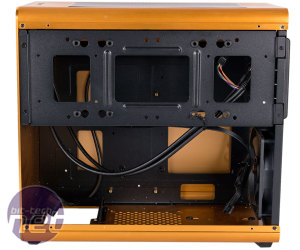
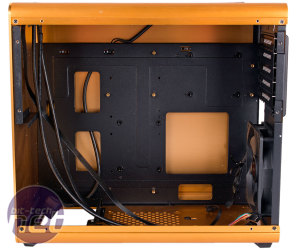
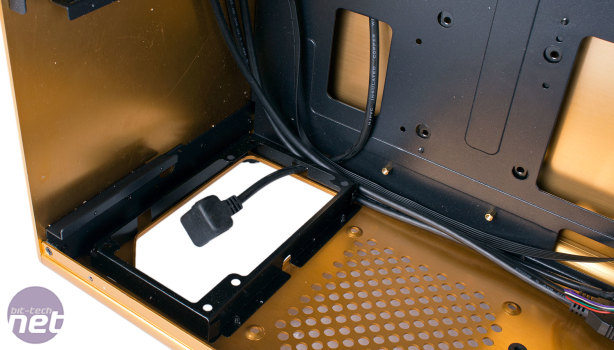
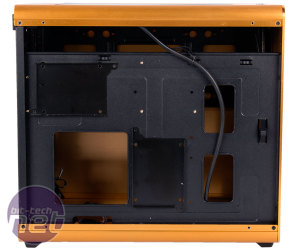
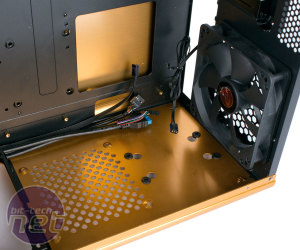








Want to comment? Please log in.